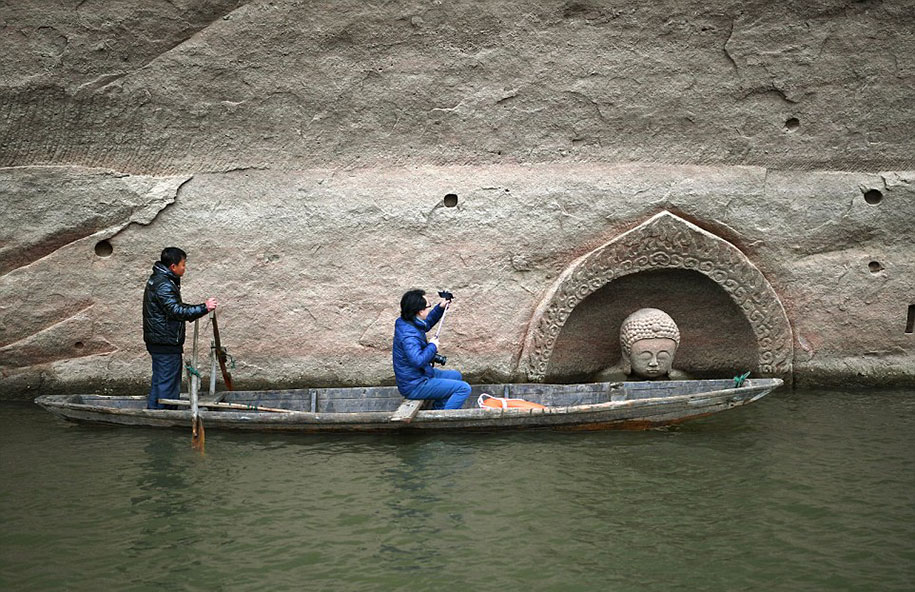The Monkees’ Micky Dolenz would like a word with the FBI

When the Monkees launched their inaugural tour in 1967, they played to throngs of screaming teenagers – and at least one FBI informant. “During the concert, subliminal messages were depicted on the screen which, in the opinion of [informant’s name redacted], constituted ‘left wing intervention of a political nature,'” reads a document in the Monkees FBI file. This tiny portion of the band’s FBI file was released to the public a little over a decade ago, and now Micky Dolenz, the group’s sole surviving member, has filed a lawsuit against the FBI. The 77-year-old musician is hoping to see the rest of the file after failing to get his hands on it via a Freedom of Information Act request.
Plunging water levels in the Yangtze River unveil 600-year-old statues
China is in the clutches of a record-breaking heat wave that has been ongoing for 70 consecutive days, and residents across the country are facing devastating impacts as a result. The heat has been compounded by bone-dry conditions, which have caused historical drought conditions for some regions, including the Yangtze River Valley. The Yangtze River is the world's third largest river and the longest river in Asia. Researchers say that portions of the river that flow through the municipality of Chongqing in southwestern China have dropped so significantly that age-old statues that date back to the Ming and Qing dynasties have been uncovered.

Rare, precious, smells like whale: hunting for ambergris in New Zealand
Ambergris -- a substance that forms in a sperm whale’s digestive tract to protect it from damage by the sharp edges of squid beaks and ocean debris and is then excreted -- is an exceedingly rare and valuable product, sought after by perfume houses and gathered by secretive harvesters among the flotsam of New Zealand’s stormy coastlines. It’s a trade known for its secrecy. Few ambergris-gatherers will speak to reporters on record, and some are fiercely – even violently – protective of their patches. Now, the centuries-old trade is being reshaped by human influence: as climate change alters weather patterns and ocean currents, patterns of ambergris distribution are shifting too.

How one TikToker convinced folks he was an AI-generated character
Curt Skelton has been obsessed with visual effects since he was a kid, when he spent hours futzing around on Adobe After Effects CS3. “I can’t imagine a life without visual effects,” says the 22-year-old Los Angeles college student and liquor store employee. “It’s been my greatest passion ever since I was in middle school.” In a video, posted on Thursday and seen 13.5 million times, Skelton convincingly (to some) reveals that he is AI-generated. Skelton claims that he is a composite of different effects — a DALL-E image wrapped around a skeleton frame and animated using gesture-tracking software. "The goal was never to trick people," he says. "They did that to themselves.”
If you believed curt skelton was AI, I have an extremely rare NFT of a bridge to sell you
— Bad Beth & Beyond (@bethmckeevr) August 26, 2022
Immortal jellyfish genes identified that may explain their long lives
An immortal species of jellyfish has double copies of genes that protect and repair DNA. The finding could provide clues to human ageing and age-related conditions. Jellyfish start their lives as drifting larvae. They eventually attach to the seafloor and develop into sprout-like polyps. The bottom-dwellers clone themselves, forming stacked, sedentary colonies that bud off into free-swimming umbrella-shaped medusas. That stage is a dead end for most jellyfish – but the immortal jellyfish (Turritopsis dohrnii) can reverse the cycle. When times get tough, like in harsh environments or after injury, they melt their bodies into amorphous cysts, reattach to the seafloor and regress into polyps. They can restart the cycle indefinitely to skirt death by old age.

“Once-in-a-generation discovery”: Early Medieval Monastery found in England
An excavation led by the University of Reading this month has revealed that the Anglo-Saxon monastery in Cookham, Berkshire, ranks alongside the most extensively preserved early medieval monastic sites ever investigated in Britain. Rarely discovered, well-preserved infrastructure, including a waterside loading area, workshops for industrial activities like metalworking, and bread ovens used to feed those who lived there, suggest that the monastery used the neighbouring river to huge advantage by extensively importing and exporting goods and materials. “This is a once-in-a-generation archaeological discovery,” says Dr Gabor Thomas, the lead archaeologist.
That's quite a name
hilarious sentence from a "personal life" section pic.twitter.com/56jDFNnsTX
— depths of wikipedia (@depthsofwiki) August 30, 2022



